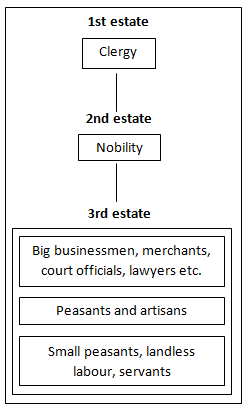Structure -Social Status of French Society










Structure -Social Status of French Society
Structure and Social Status of French Society in 18th Century: In the 18th century, French society was divided into three estates
The Church took taxes called tithes from the peasants. All members of the third estate had to pay taxes to the state. This included taitle, a direct tax and a number of indirect taxes imposed on articles of everyday consumption like salt or tobacco. This estate alone had burden of financing activities of state.

The Struggle to Survive: During 1715-1789, the population of France increased from 23 to 28 million. This led to a rapid increase in demand for food grains. But the production did not increase. The price of bread rose rapidly. It was the staple diet of the majority. Most workers were employed as labourers in workshops, whose owners fixed their wages. Their wages did not keep pace with the rise in prices. So, the gap between the poor and the rich widened. It became worse when bad weather conditions reduced the harvest. This frequently created a subsistence crisis.
A Growing Middle Class Envisages an End to Privileges
In the past, peasants and workers had participated in revolts against increasing taxes and food scarcity. But they lacked the sources and programmes to carry out full scale measures that would bring about a change in the social and economic order. This was left to the groups of the third estate who had become prosperous and had access to education and new ideas.
During ______________ the population of France increased from ___________ million. | |||
| Right Option : A | |||
| View Explanation | |||
What was the name of tax which was directly paid to be state by the Third Estate? | |||
| Right Option : C | |||
| View Explanation | |||
Which of the following Constituted the privileged class? | |||
| Right Option : D | |||
| View Explanation | |||
Students / Parents Reviews [10]
Being a parent, I saw my daughter improvement in her studies by seeing a good result in all day to day compititive exam TMO, NSO, IEO etc and as well as studies. I have got a fruitful result from my daughter.

Prisha Gupta
8thI have spent a wonderful time in Abhyas academy. It has made my reasoning more apt, English more stronger and Maths an interesting subject for me. It has given me a habbit of self studying

Yatharthi Sharma
10thMy experience with Abhyas academy is very good. I did not think that my every subject coming here will be so strong. The main thing is that the online tests had made me learn here more things.

Hiya Gupta
8thAbout Abhyas metholodology the teachers are very nice and hardworking toward students.The Centre Head Mrs Anu Sethi is also a brilliant teacher.Abhyas has taught me how to overcome problems and has always taken my doubts and suppoeted me.

Shreya Shrivastava
8thAbhyas is a complete education Institute. Here extreme care is taken by teacher with the help of regular exam. Extra classes also conducted by the institute, if the student is weak.

Om Umang
10thOne of the best institutes to develope a child interest in studies.Provides SST and English knowledge also unlike other institutes. Teachers are co operative and friendly online tests andPPT develope practical knowledge also.

Aman Kumar Shrivastava
10thIt has a great methodology. Students here can get analysis to their test quickly.We can learn easily through PPTs and the testing methods are good. We know that where we have to practice

Barkha Arora
10thAbhyas Methodology is very good. It is based on according to student and each child manages accordingly to its properly. Methodology has improved the abilities of students to shine them in future.

Manish Kumar
10thIt was good as the experience because as we had come here we had been improved in a such envirnment created here.Extra is taught which is beneficial for future.

Eshan Arora
8thIt was a good experience with Abhyas Academy. I even faced problems in starting but slowly and steadily overcomed. Especially reasoning classes helped me a lot.
